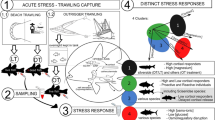Abstract
Cortisol is the principal corticosteriod in teleost fishes and its plasma concentrations rise dramatically during stress. The relationship between this cortisol increase and its metabolic consequences are subject to extensive debate. Much of this debate arises from the different responses of the many species used, the diversity of approaches to manipulate cortisol levels, and the sampling techniques and duration. Given the extreme differences in experimental approach, it is not surprising that inconsistencies exist within the literature. This review attempts to delineate common themes on the physiological and metabolic roles of cortisol in teleost fishes and to suggest new approaches that might overcome some of the inconsistencies on the role of this multifaceted hormone. We detail the dynamics of cortisol, especially the exogenous and endogenous factors modulating production, clearance and tissue availability of the hormone. We focus on the mechanisms of action, the biochemical and physiological impact, and the interaction with other hormones so as to provide a conceptual framework for cortisol under resting and/or stressed states. Interpretation of interactions between cortisol and other glucoregulatory hormones is hampered by the absence of adequate hormone quantification, resulting in correlative rather than causal relationships.
The use of mammalian paradigms to explain the teleost situation is generally inappropriate. The absence of a unique mineralocorticoid and likely minor importance of glucose in fishes means that cortisol serves both glucocorticoid and mineralocorticoid roles; the unusual structure of the fish glucocorticoid receptor may be a direct consequence of this duality. Cortisol affects the metabolism of carbohydrates, protein and lipid. Generally cortisol is hyperglycaemic, primarily as a result of increases in hepatic gluconeogenesis initiated as a result of peripheral proteolysis. The increased plasma fatty acid levels during hypercortisolaemia may assist to fuel the enhanced metabolic rates noted for a number of fish species. Cortisol is an essential component of the stress response in fish, but also plays a significant role in osmoregulation, growth and reproduction. Interactions between cortisol and toxicants may be the key to the physiology of this hormone, although cortisol's many important housekeeping functions must not be ignored. Combining molecular approaches with isolated cell systems and the whole fish will lead to an improved understanding of the many faces of this complex hormone in an evolutionary and environmental framework.
Similar content being viewed by others
Author information
Authors and Affiliations
Rights and permissions
About this article
Cite this article
Mommsen, T.P., Vijayan, M.M. & Moon, T.W. Cortisol in teleosts: dynamics, mechanisms of action, and metabolic regulation. Reviews in Fish Biology and Fisheries 9, 211–268 (1999). https://doi.org/10.1023/A:1008924418720
Issue Date:
DOI: https://doi.org/10.1023/A:1008924418720




